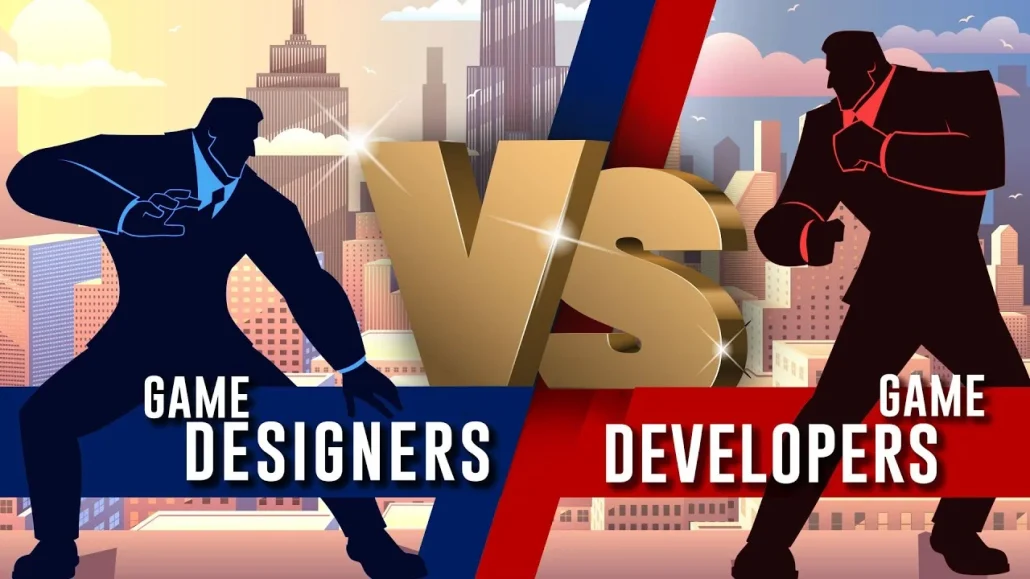The world of game development is dynamic, a world in which creativity and technical expertise converge to create immersive gaming experiences. In this article, we will explore the roles of game designers and game developers, shedding light on their distinct responsibilities, skills, and the differences between game design vs game development.
What is Game Design?
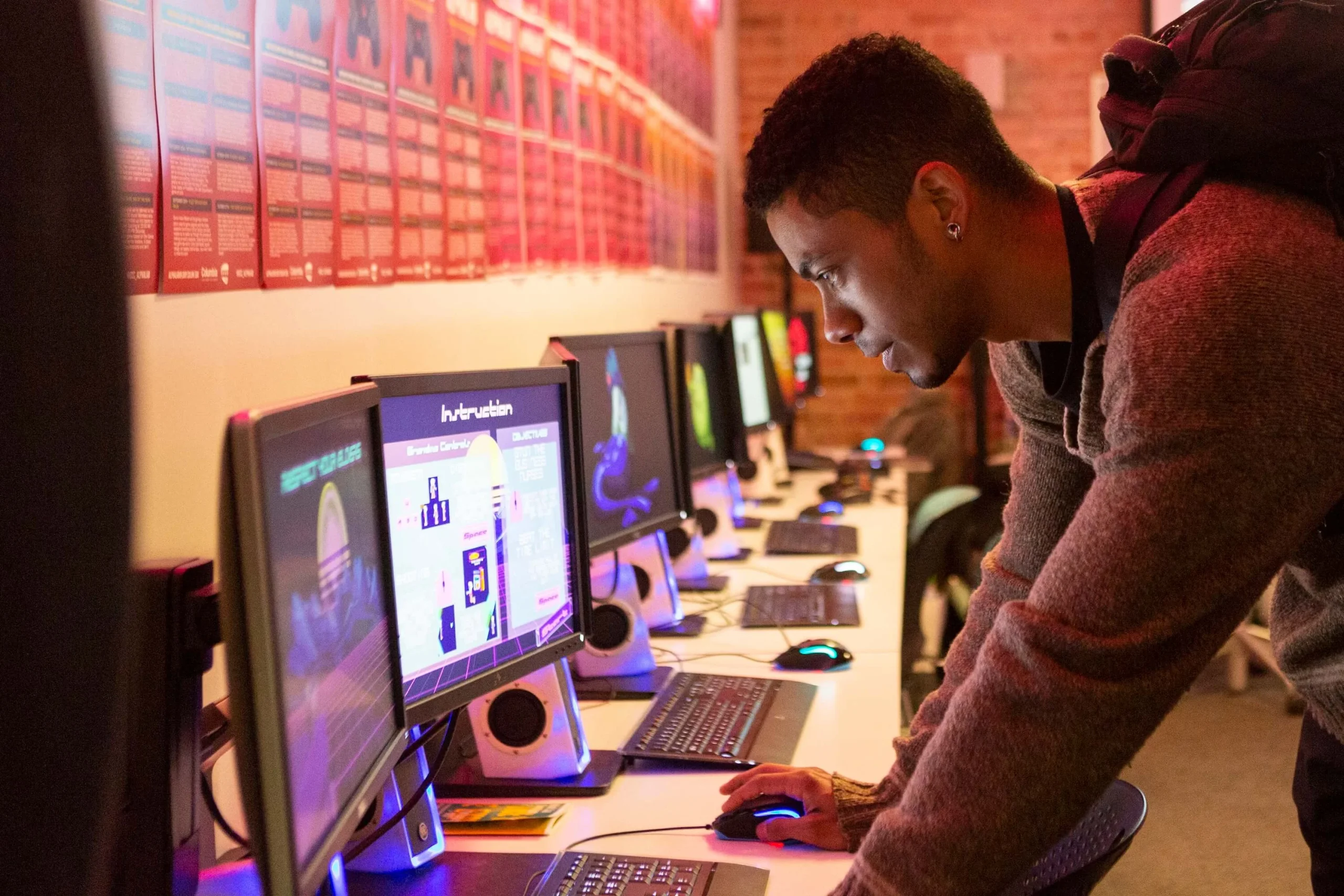

Game design refers to conceptualizing and creating a video game’s overall structure, mechanics, and aesthetics. It encompasses the creative and artistic elements of game development, focusing on crafting engaging gameplay experiences for players. Game design involves a combination of imagination, problem-solving, storytelling, and interactive design principles to shape the player’s journey within the game.
Game design involves defining the game’s objectives, rules, challenges, and rewards. Game designers are responsible for creating the game’s concept, including its storyline, characters, environments, and gameplay mechanics. They collaborate with artists, programmers, and other development team members to translate their ideas into a functional and enjoyable game.
Game designers use various tools and techniques to bring their ideas to life. They create game prototypes, design levels, balance gameplay mechanics, and conduct playtesting to gather feedback and refine the game experience. They also consider factors such as player engagement, immersion, and overall game flow to ensure that the final product provides players an enjoyable and memorable experience.
What is Game Programming?


Game programming refers to the process of writing code and developing the software that powers video games. It involves the implementation of game mechanics, artificial intelligence, physics simulations, user interfaces, audio systems, and other technical aspects necessary for the game to function and provide an interactive experience.
Game programmers work closely with game designers to bring their vision to life. They use programming languages such as C++, C#, or Python to write the underlying code that controls the behavior of characters, objects, and environments within the game. They also integrate various assets like 3d modeling studio, textures, and sound effects into the game engine to create a cohesive and immersive experience.
Game programmers tackle various tasks, including creating game systems, implementing gameplay features, optimizing performance, debugging issues, and ensuring compatibility across different platforms and devices. They work with game engines and development tools to streamline the programming process and leverage existing frameworks and libraries.
What is Game Development?
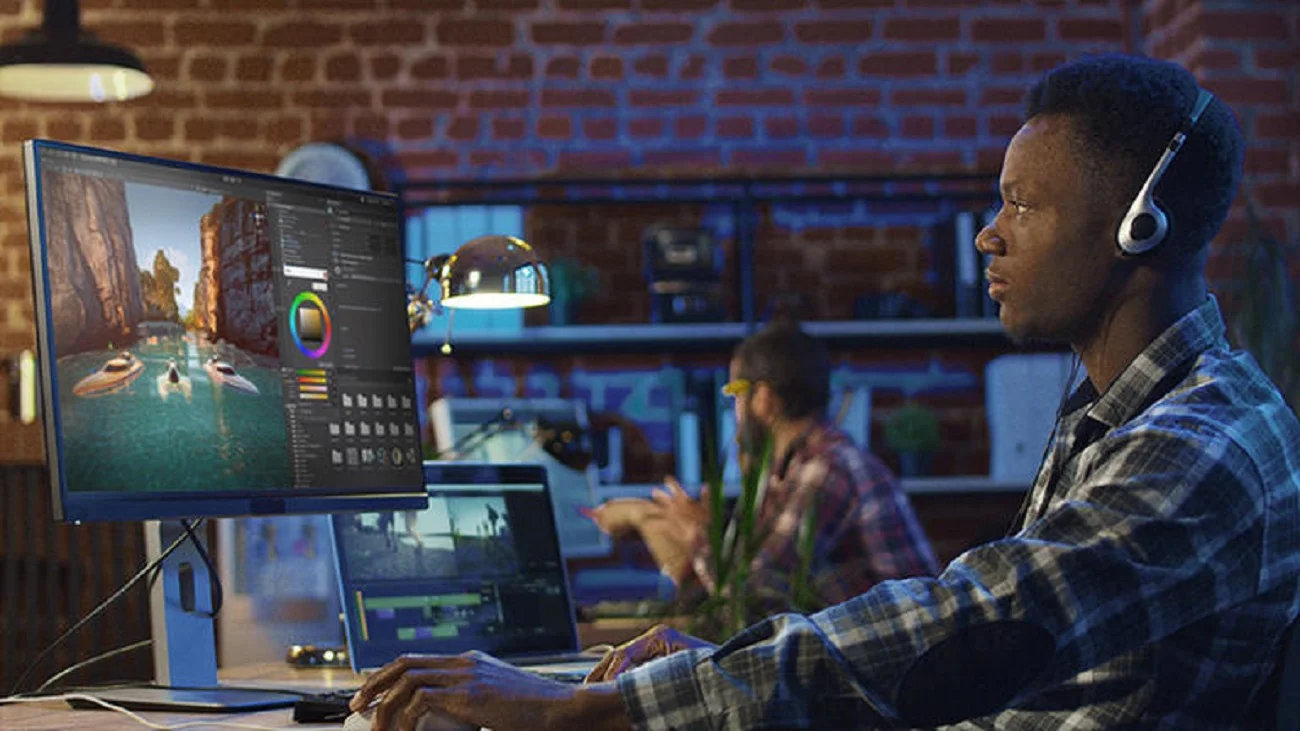

Game development encompasses the entire video game creation process, from the initial concept and design to the final release and distribution. It involves a collaborative effort of individuals with different skill sets, including game designers, programmers, artists, sound designers, and testers, who work together to bring the game to life.
What Does a Game Designer Do?
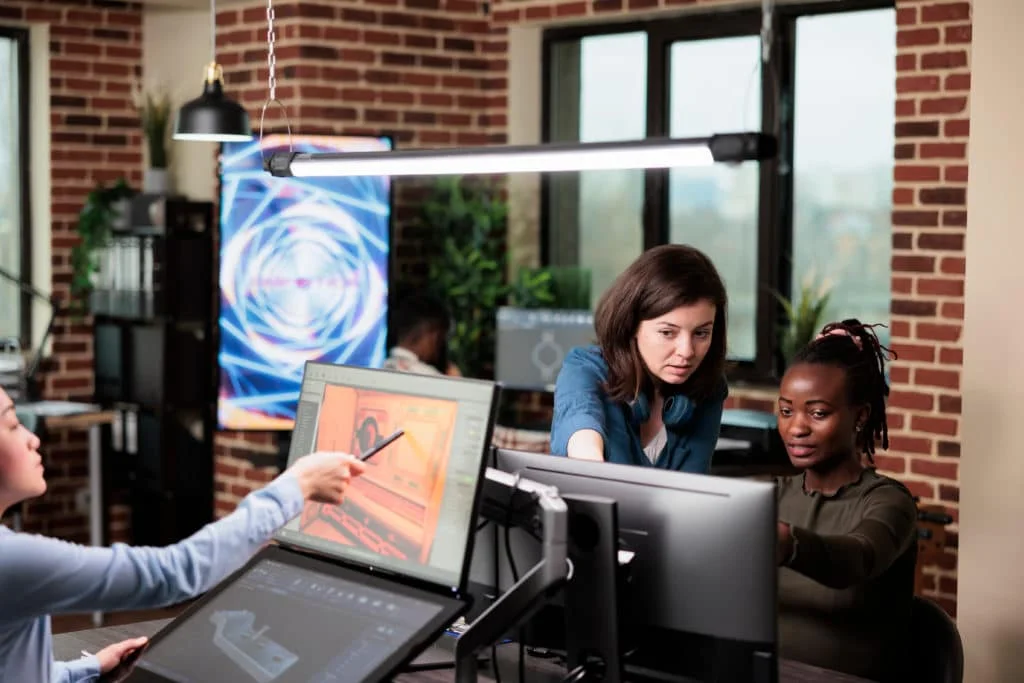

A game designer is responsible for shaping a video game’s overall vision and design. They are involved in game development’s creative and conceptual aspects, focusing on gameplay mechanics, level design, storylines, and player experiences. Game designers work closely with other team members, such as programmers, artists, and writers, to bring their ideas to life.
The primary role of a game designer is to create engaging and enjoyable gameplay experiences. They develop game mechanics, which are the rules, systems, and interactions that define how the game is played. This includes designing the core gameplay loop, character abilities, level progression and balancing the difficulty to ensure a satisfying and immersive experience for players.
Game designers also work on level design, creating the layout, structure, and challenges of individual game levels or environments. They determine the placement of obstacles, enemies, and items to create engaging and strategic gameplay. Level designers need to consider factors like player navigation, pacing, and the game’s overall flow.
In addition to gameplay and level design, game designers contribute to a game’s narrative and storytelling elements. They develop the game’s storylines, character backgrounds, and dialogues, ensuring they align with the game’s theme and engage the player.
Collaboration and communication skills are crucial for game designers, as they must work closely with other team members to bring their ideas to fruition. They participate in brainstorming sessions, provide feedback on art and programming aspects, and iterate on designs based on playtesting and user feedback.
What Does a Game Programmer Do?


A game programmer is responsible for writing the code that brings a video game to life. They are skilled in programming languages and work closely with other team members, such as game designers and artists, to implement the game’s functionality, mechanics, and features.
The primary role of a game programmer is to translate the game design into a functional software program. They write the code that controls the behavior of characters, objects, and environments in the game. This includes implementing gameplay mechanics, physics simulations, artificial intelligence (AI), and user interfaces.
Game programmers also optimize the game’s performance by writing efficient code and implementing techniques to ensure smooth gameplay and responsive controls. They work on reducing lag, optimizing memory usage, and minimizing loading times to enhance the player experience.
In addition to gameplay programming, game programmers may specialize in specific areas such as graphics programming, networking, audio, or physics. Graphics programmers focus on rendering techniques, lighting effects, and visual enhancements. Network programmers develop the online multiplayer functionality and ensure smooth communication between players. Audio programmers work on integrating sound effects and music into the game, while physics programmers handle the realistic simulation of objects and their interactions.
Game programmers collaborate closely with game designers to understand their vision and requirements, and then translate those into code. They participate in team meetings, provide technical expertise, and work on troubleshooting and debugging issues that arise during development.
Problem-solving skills and strong knowledge of programming languages and game development tools are essential for game programmers. They continuously update their skills to stay current with new technologies and trends in the gaming industry.
Key Differences Between Game Design vs Game Development
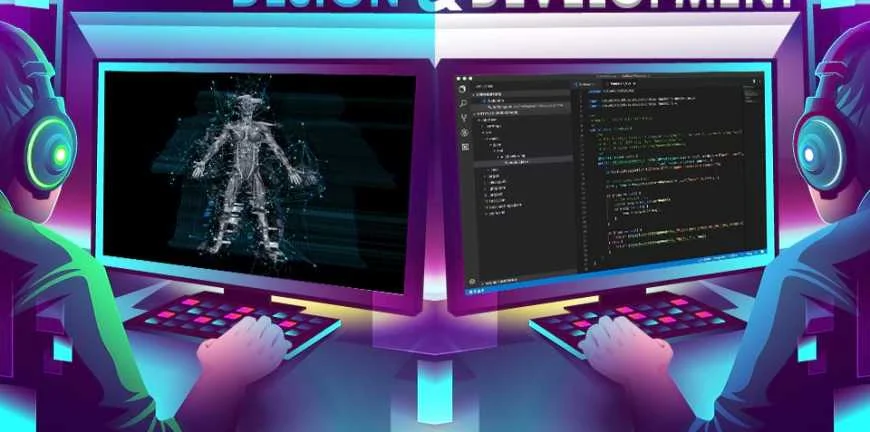

When it comes to creating video games, two key roles contribute to the development process: Game Design vs Game Development. While these terms are often used interchangeably, they encompass distinct areas of expertise and responsibilities. Understanding the differences between game development and game design is essential for aspiring game professionals and enthusiasts alike. Here, we go through some of the most major differences:
Curriculum
When it comes to the curriculum for Game Design vs Game Development, there are notable differences in the areas of focus and the skills covered. The curriculum for game development typically emphasizes technical skills and programming knowledge. Students in game development programs often learn programming languages such as C++, Java, or Python, as well as software development methodologies and tools. They acquire knowledge of in-game physics, artificial intelligence, networking, and graphics programming. Additionally, they may gain expertise in specific game development engines or platforms, such as Unity or Unreal Engine.
On the other hand, the game design curriculum emphasizes the creative and artistic aspects of game creation. Students learn about game design principles, storytelling techniques, level design, character development, and visual aesthetics. They explore topics related to game mechanics, game theory, player psychology, and user experience (UX) design. Game design programs often incorporate hands-on projects and collaborative work to allow students to apply their knowledge and develop their skills in designing compelling and engaging games.
It is worth noting that some interdisciplinary programs or courses offer a combination of Game Design vs Game Development, allowing students to gain a broader understanding of both disciplines. These programs cater to individuals who are interested in exploring various aspects of game creation and want to develop a versatile skill set that encompasses both technical and creative proficiencies.
Skills
When it comes to the skills required for Game Design vs Game Development, there are notable distinctions based on the nature of the work involved. Game developers need strong programming and technical skills to bring game concepts to life. They should be proficient in programming languages such as C++, C#, Java, or Python and know game development frameworks and engines like Unity or Unreal Engine. Problem-solving abilities, logical thinking, and attention to detail are crucial in programming game mechanics, physics, AI, and other technical aspects.
In contrast, game designers rely more on their creative and artistic skills to conceptualize and design engaging gameplay experiences. They need a strong understanding of game design principles, including mechanics, level design, pacing, and player engagement. Storytelling and narrative design skills are important for crafting compelling game worlds and characters. Additionally, proficiency in visual design, including 2D art production or 3D art production, animation, and user interface (UI) design, can greatly enhance a game designer’s ability to communicate their ideas effectively.
Both game developers and game designers benefit from strong communication and collaboration skills. They often work in multidisciplinary teams, collaborating with artists, programmers, sound designers, and other professionals. The ability to effectively communicate ideas, provide constructive feedback, and work collaboratively is essential for creating cohesive and successful game projects.
Moreover, problem-solving, adaptability, and a passion for gaming are shared skills between game developers and game designers. Both roles require individuals to think creatively, analyze challenges, and find innovative solutions. Staying updated with industry trends, playing and analyzing various games, and being open to continuous learning is important for staying competitive in the ever-evolving field of game development.
Qualifications
Regarding qualifications, the requirements for Game Design vs Game Development can vary depending on the employer, the specific role, and the level of experience sought. However, some common qualifications are often sought after in these fields.
A bachelor’s degree in computer science, software engineering, or a related field is typically preferred for game development. This educational background provides a solid foundation in programming concepts and algorithms. Some employers may also consider candidates with degrees in game development, interactive media, or game design, which offer a more specialized focus on game-related topics.
In the case of game design, a bachelor’s degree in game design, interactive media, or a related field is often preferred. These programs give students a strong understanding of game design principles, mechanics, storytelling, and player experience. Additionally, computer science, graphic design, or animation degrees can also be relevant for aspiring game designers, as they provide complementary skills and knowledge.
While formal education is valuable, practical experience and a strong portfolio are highly regarded in the Game Design vs Game Development industries. Demonstrating proficiency in relevant software tools, showcasing completed projects or prototypes, and participating in game jams or internships can significantly enhance applicants’ qualifications and make them more competitive in the job market.
Furthermore, ongoing learning and professional development are crucial in the game industry, where technology and trends evolve rapidly. Attending workshops, conferences, and online courses, as well as staying updated with the latest tools and techniques, can demonstrate a commitment to growth and improvement in the field of game development or game design.
Job Roles and Responsibilities
The game designer is responsible for developing the concept, gameplay mechanics, level design, and overall user experience of the game. They work closely with artists, programmers, and other team members to bring their vision to life.
Game programmers or game developers are responsible for coding the game’s functionality, including implementing gameplay features, user interfaces, artificial intelligence, and physics systems. They work with game engines and programming languages to bring the game designer’s vision into a playable reality.
Salary
The salary range in the game development industry varies depending on factors such as job role, experience level, location, company size, and project budget. Here are some general salary ranges for these two key roles in game development:
- Game Designer: The salary of a game designer can vary widely based on experience and the size of the company. Entry-level game designers may earn around $50,000 to $70,000 per year, while experienced designers or those working on high-profile projects can earn salaries ranging from $70,000 to $100,000 or more.
- Game Programmer: Game programmers are in high demand, and their salaries reflect their technical expertise. Entry-level programmers can expect salaries around $60,000 to $80,000 per year, while experienced programmers with specialized skills or working on AAA projects may earn salaries ranging from $80,000 to $120,000 or more.
Which is Better: Game Designer or Game Developer?
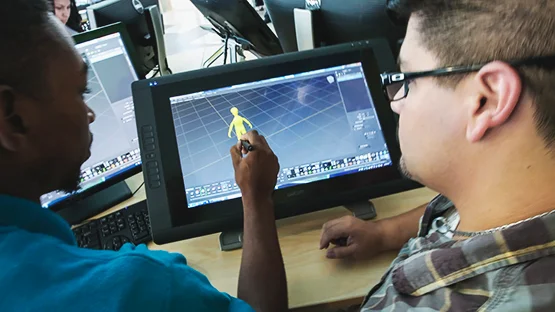

The question of whether being a game designer or a game developer is better is subjective and depends on individual preferences, skills, and career goals. Both roles are integral to the game development process and contribute to the creation of immersive and engaging games. Here are some factors to consider when comparing game designer vs game developer roles:
- Skill Set: Game designers focus on the creative aspects of game development, such as conceptualizing game mechanics, designing levels, creating storylines, and developing gameplay systems. On the other hand, game developers, specifically programmers, are responsible for coding and implementing the technical aspects of the game, such as physics, artificial intelligence, and user interfaces.
- Job Responsibilities: Game designers primarily work on the overall game concept, mechanics, and player experience. They collaborate with artists, programmers, and other team members to ensure the game’s vision is realized. Game developers, especially programmers, focus on writing code, debugging, optimizing performance, and integrating different game systems.
- Career Path: Game designers often have a broader scope of creative opportunities within the game industry, such as becoming creative directors, lead designers, or narrative designers. Game developers, particularly programmers, can specialize in specific areas such as gameplay programming, graphics programming, or engine development, and have opportunities to become technical leads, senior programmers, or even work in related industries like software development.
- Personal Interests and Skills: The choice between game design and game development often depends on personal interests and skills. Game design may be the better fit if you have a passion for storytelling, game mechanics, and player experience. On the other hand, if you enjoy coding, problem-solving, and working with technology, game development, specifically programming, may be more suitable.
Ultimately, the decision between game designer vs game developer depends on individual preferences, strengths, and career aspirations. Some individuals may even find enjoyment in combining both design and development skills to become well-rounded professionals in the game industry.
Video Game Designer vs Developer
In the world of video game development, a video game developer is primarily responsible for the technical aspects of creating a game. They handle coding, programming, and the implementation of the game’s functionality. Developers build the underlying systems that make a game run, including physics, artificial intelligence, networking, and optimization.
On the other hand, a video game designer focuses on the creative and conceptual aspects of game development. They craft the game’s rules, mechanics, story, level design, and overall player experience. Game designers work on how the game should be played, striving to create engaging and immersive gameplay. They collaborate with artists, writers, and other team members to bring their vision to life.
While both roles are essential, developers are the technical architects behind the scenes, while designers are the creative visionaries shaping the player’s experience.

What is Video Game Development?
Video Game Development follows certain steps:
- Concept and Design: The development process starts with concept and design. Game designers create the game’s concept, story, characters, and gameplay mechanics. They outline the game’s objectives and challenges.
- Pre-production: During the pre-production phase, the development team plans the game’s scope, budget, and timeline. Artists and designers create concept art and storyboards, while programmers lay the technical groundwork.
- Production: In this phase, the actual development begins. Artists create 2D or 3D assets, level designs are crafted, and programmers write code to implement gameplay features, AI, physics, and more.
- Testing and Quality Assurance: Quality assurance (QA) testers play a crucial role in identifying bugs and providing feedback on gameplay. The development team iteratively refines the game based on their findings.
- Marketing and Promotion: Preparing for the game’s release, marketing efforts include creating promotional materials, trailers, and building hype among the gaming community.
- Distribution and Release: Once the game is polished and ready, it is distributed to players through various platforms, such as consoles, PCs, and mobile devices. The release phase also involves launching updates and patches as needed.
- Post-launch Support: Post-launch, developers continue to support the game with updates, bug fixes, and additional content to maintain player engagement.
Video game development requires collaboration among diverse professionals, including artists, designers, writers, programmers, sound engineers, and producers. The successful execution of these phases results in a playable and enjoyable video game that captivates players and immerses them in its virtual world.
What is Video Game Designing?
Video Game Designing has numerous aspects. Some of them are as follows:
- Gameplay Design: Gameplay design involves defining the core mechanics and rules of the game. This includes how the player interacts with the game world, the objectives they need to accomplish, and the challenges they must overcome.
- Level and World Design: Game designers create the layout of levels, maps, and game worlds. They determine the placement of obstacles, enemies, items, and environmental elements to provide a balanced and enjoyable gaming experience.
- Storytelling and Narrative Design: For games with a narrative, designers craft the storyline, characters, and dialogues. They ensure that the game’s plot aligns with its gameplay and engages players emotionally.
- Game Balance and Progression: Designers are responsible for balancing the difficulty of the game and ensuring that players experience a sense of progression. They adjust parameters such as enemy strength, item availability, and character abilities to create a satisfying learning curve.
- User Experience (UX) Design: UX designers focus on optimizing the player’s interaction with the game. This includes designing user interfaces, menus, and controls to be intuitive and user-friendly.
- Sound and Music Design: Game designers collaborate with sound engineers and composers to create audio elements that enhance the game’s atmosphere and immersion.
- Player Psychology: Understanding player behavior, motivation, and engagement is a crucial aspect of game design. Designers analyze player feedback and data to improve the game’s design.

